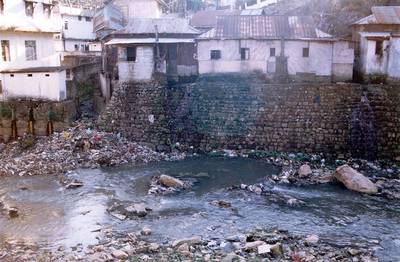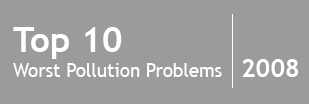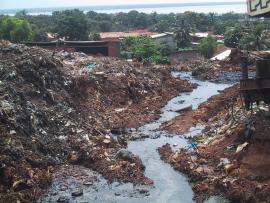Untreated Sewage
Description
Sewage refers to liquid wastes containing a mixture of human feces and wastewater from non-industrial human activities such as bathing, washing, and cleaning. In many poor areas of the world, sewage is dumped into local waterways, in the absence of practical alternatives.
Untreated sewage poses a major risk to human health since it contains waterborne pathogens that can cause serious human illness. Untreated sewage also destroys aquatic ecosystems, threatening human livelihoods, when the associated biological oxygen demand and nutrient loading deplete oxygen in the water to levels too low to sustain life.
Context
The World Health Organization (WHO) estimates that 2.6 billion people lacked access to improved sanitation facilities in 2008, with the lowest coverage in sub-Saharan Africa (37%), Southern Asia (38%), and Eastern Asia (45%).1 Improved sanitation facilities are those that eliminate human contact with fecal material and include flush or pit toilets/latrines and composting toilets.2 Even where water based toilets are available, the wastes are far too often just discharged into drains and streams, in the absence of (expensive) collection and treatment systems. As a result, surface waters in many urban areas are highly contaminated with human waste. In areas with pit latrines, seepage into local groundwater is often a major problem, since many communities rely on shallow wells for drinking water.
Lack of access to improved sanitation disproportionately affects poor communities in urban and rural areas where resources for investments in collection and treatment infrastructure are scarce, although the challenge of maintaining existing systems to protect humans from waterborne disease outbreaks affects even the world’s richest communities.
Exposure Pathways
Sewage can be intentionally discharged to waterways through pipes or open defecation, or unintentionally during rainfall events. When humans use these waterways for drinking, bathing or washing, they are exposed to the associated pathogens, many of which can live for extended periods of time in aquatic environments. Humans then become ill by ingesting contaminated water, by getting it on/in skin, eyes or ears, or even from preparing foods with contaminated water. Sometimes humans can even become ill from inhaling contaminated water droplets.
Health Effects
Life-threatening human pathogens carried by sewage include cholera, typhoid and dysentery. Other diseases resulting from sewage contamination of water include schistosomiasis, hepatitis A, intestinal nematode infections, and numerous others. WHO estimates that 1.5 million preventable deaths per year result from unsafe water, inadequate sanitation or hygiene.3 These deaths are mostly young children. Another 860,000 children less than five years old are estimated to die annually as a direct or indirect result of the underweight or malnutrition associated with repeated diarrheal or intestinal nematode infections .4
What is Being Done
Strides are being made on a global scale. The WHO estimated that 3.8 billion people had access to improved sanitation as of 2004, and has set a target of at least 75% global coverage by 2015. Meeting this ambitious target will be a challenge. However, a number of interventions have already proven effective in reducing the diarrheal disease burden resulting from inadequate sanitation.5 These range from hand washing and hygiene education, to toilet/latrine installation and point-of-use water treatment, to approaches comprised of multiple strategies.
Footnotes
1 World Health Organization (WHO). 2008. “International Year of Sanitation 2008” Last accessed on September 16, 2008. Available at http://www.who.int/water_sanitation_health/hygiene/iys/about/en/index.html.2 WHO and United Nations Children’s Fund Joint Monitoring Programme for Water Supply and Sanitation (JMP). 2008. Progress on Drinking Water and Sanitation: Special Focus on Sanitation. UNICEF, New York and WHO, Geneva, Last accessed September 16, 2008. Available at: http://www.who.int/water_sanitation_health/monitoring/jmp2008.pdf.
3 Pruss-Ustun A, Bos R, Gore F, Bartram J. 2008. Safer water, better health: costs, benefits and sustainability of interventions to protect and promote health. Geneva: World Health Organization [Available: http://www.who.int/quantifying_ehimpacts/publication/saferwater/en/index.html, accessed 9/15/08].
4 Pruss-Ustun A, Bos R, Gore F, Bartram J. 2008. Safer water, better health: costs, benefits and sustainability of interventions to protect and promote health. Geneva: World Health Organization [Available: http://www.who.int/quantifying_ehimpacts/publications/saferwater/en/index.html, accessed 9/15/08].
5 Fewtrell L, Kaufmann RB, Kay D, Enanoria W, Haller L, Colford JM Jr. 2005. Water, sanitation,and hygiene interventions to reduce diarrhoea in less developed countries: a systematic review and metaanalysis. The Lancet Infectious Diseases, 5(1):42–52.
Additional Resources
Untreated Sewage (word doc)
Additional Photos
| Sewage and surface water pollution. Guinea. Photo by Blacksmith Institute. | |
 |
Untreated sewage. Shillong Dump, India. Photo by Blacksmith Institute. |




